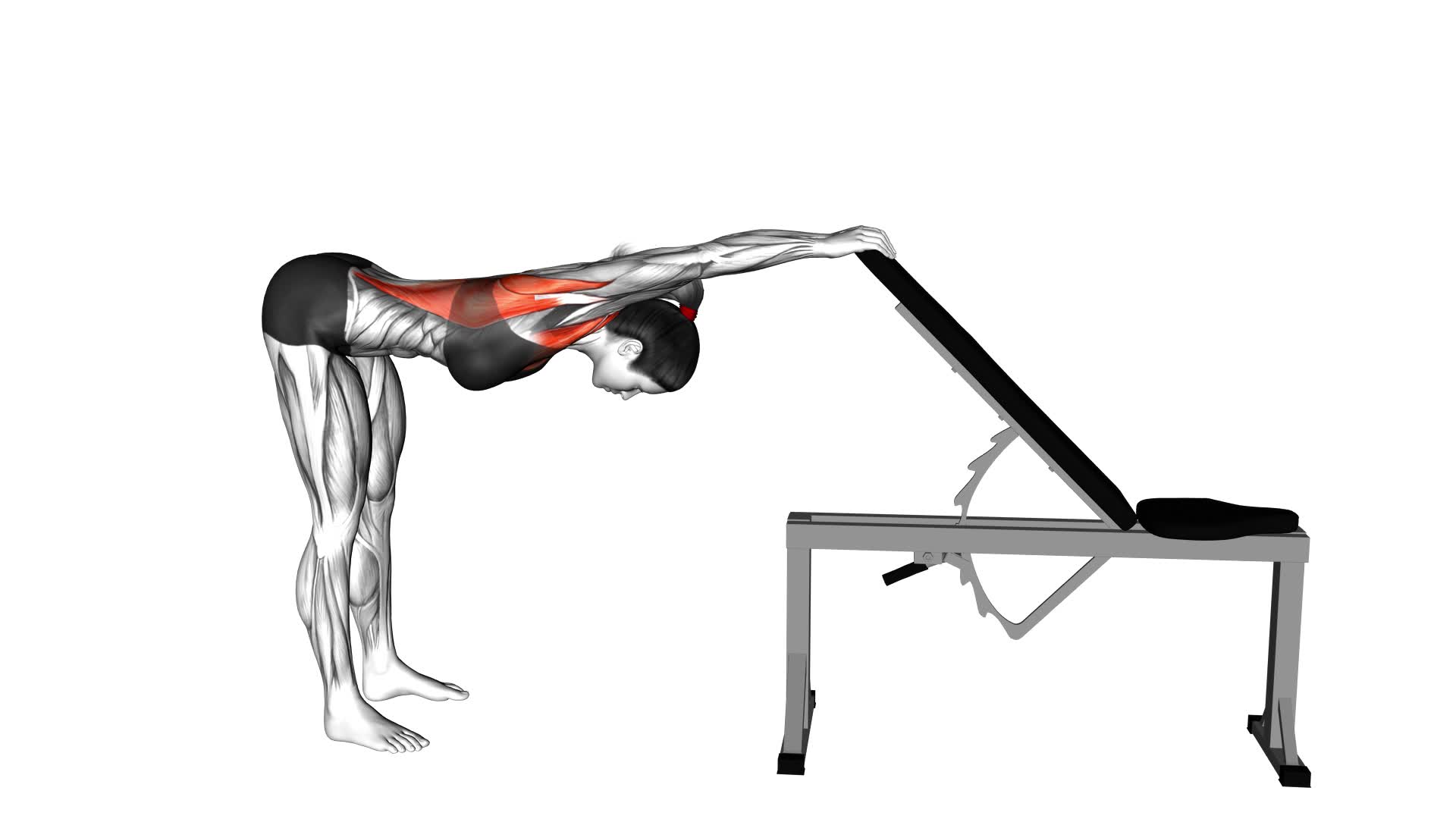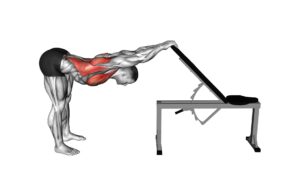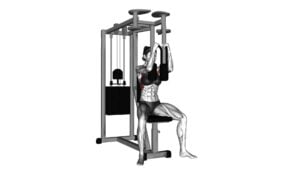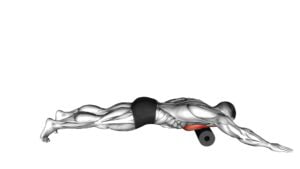Back Pec Stretch (female) – Video Exercise Guide & Tips

Are you looking to improve your flexibility and relieve tension in your upper body? Then the back pec stretch is the perfect exercise for you.
Watch This Exercise Video
In this video exercise guide, we'll show you step-by-step instructions on how to perform this stretch correctly. Whether you're a beginner or an experienced fitness enthusiast, we've got modifications to suit your level.
Avoid common mistakes and get the most out of this stretch with our helpful tips.
Let's get started!
Key Takeaways
- The Back Pec Stretch improves flexibility and range of motion in the upper body.
- It alleviates muscle tension and reduces the risk of injury.
- It counters the effects of poor posture and sitting for long periods.
- The stretch targets and stretches back and pectoral muscles.
Benefits of the Back Pec Stretch
To effectively target and stretch your back and pectoral muscles, the Back Pec Stretch provides numerous benefits for you. This stretch is important because it helps to improve flexibility and range of motion in your upper body. By stretching your back and chest muscles, you can alleviate muscle tension and reduce the risk of injury. The Back Pec Stretch also helps to counteract the effects of poor posture and sitting for long periods.
There are different variations of the Back Pec Stretch that you can incorporate into your routine. One variation involves using a wall or doorway to stretch your chest muscles. Another variation involves using a foam roller to target specific areas of your back. These variations allow you to customize the stretch to meet your specific needs and goals.
Step-by-Step Instructions for the Back Pec Stretch
To perform the Back Pec Stretch, follow these step-by-step instructions.
- Start by finding a sturdy doorway or corner to perform the stretch.
- Stand with your feet shoulder-width apart, facing the doorway or corner.
- Raise your arms to shoulder height and bend your elbows at a 90-degree angle, placing your forearms flat against the wall or doorframe.
- Keep your back straight and engage your core muscles.
Next, begin to slowly lean forward, allowing your chest to move towards the wall or corner. You should feel a gentle stretch in your chest and shoulders. Hold this position for 20-30 seconds, focusing on deep breathing and relaxing your muscles. Remember to maintain proper posture throughout the stretch.
As you continue to practice the Back Pec Stretch, you'll experience several benefits. Stretching your chest muscles can help improve your posture by counteracting the effects of sitting for long periods and hunching over electronic devices. It can also help alleviate tension and tightness in the chest and shoulders, reducing the risk of muscle imbalances and injuries.
Modifications for Beginners and Experienced Fitness Enthusiasts
As you progress in your fitness journey, there are several modifications you can make to the Back Pec Stretch to accommodate both beginners and experienced fitness enthusiasts.
For beginners, it's important to start with a lighter stretch to avoid straining the muscles. One modification you can try is reducing the range of motion by keeping your arms closer to your body. This will provide a gentler stretch and allow your muscles to gradually adapt to the movement.
Another modification for beginners is to perform the stretch while seated instead of standing. This will provide additional support and stability, making it easier to maintain proper form and avoid unnecessary strain.
For more advanced fitness enthusiasts, there are modifications that can intensify the stretch and target the muscles even further. One option is to use a resistance band or towel to increase the tension. By pulling the band or towel apart while performing the stretch, you can engage the muscles more deeply and achieve a greater stretch.
Additionally, advanced modifications may involve incorporating other exercises or stretches into the routine to create a more challenging and comprehensive workout. This could include combining the Back Pec Stretch with exercises that target the upper back, shoulders, or core muscles.
Common Mistakes to Avoid During the Back Pec Stretch
You should avoid these common mistakes when performing the Back Pec Stretch:
- Rounding the shoulders: It's important to maintain proper form during the Back Pec Stretch. Many people make the mistake of rounding their shoulders forward, which can reduce the effectiveness of the stretch and potentially lead to injury. Instead, focus on keeping your shoulders back and down, maintaining a straight line from your head to your tailbone.
- Overstretching the neck: Another common mistake is overstretching the neck during the Back Pec Stretch. This can put unnecessary strain on the muscles and joints of the neck, leading to discomfort or even pain. To avoid this, keep your neck in a neutral position, neither tilting it too far forward nor extending it too far back.
- Not holding the stretch long enough: One final mistake to avoid isn't holding the stretch long enough. To fully benefit from the Back Pec Stretch, it's important to hold the position for at least 20-30 seconds. This allows the muscles to fully relax and elongate, promoting improved flexibility and range of motion.
Tips for Getting the Most Out of the Back Pec Stretch
To maximize the effectiveness of the Back Pec Stretch, incorporate these tips into your routine.
- First and foremost, focus on improving flexibility. Flexibility plays a crucial role in performing the stretch correctly and safely. Make sure to warm up before attempting the stretch to prepare your muscles and joints for the movements.
- Next, try different variations and progressions of the Back Pec Stretch. This will help target different areas of your chest and shoulders. For example, you can perform the stretch while standing against a wall or lying on a foam roller. These variations will provide a deeper stretch and help you achieve better results.
- Remember to maintain proper form throughout the stretch. Keep your back straight, shoulders relaxed, and engage your core. Avoid rounding your shoulders or arching your back, as this can lead to strain or injury.
- Finally, listen to your body and adjust the intensity of the stretch accordingly. Start with a gentle stretch and gradually increase the intensity as your flexibility improves. It's important to find a balance between challenging yourself and avoiding pain or discomfort.
Incorporating these tips into your Back Pec Stretch routine will help you improve flexibility, explore different variations and progressions, and ultimately get the most out of the stretch.
Frequently Asked Questions
How Often Should I Perform the Back Pec Stretch?
To get the most out of the back pec stretch, it's important to know how often to do it.
Regularly incorporating this stretch into your routine can have numerous benefits. By stretching your back and pec muscles, you can improve flexibility, reduce muscle tension, and enhance posture.
Can the Back Pec Stretch Help Improve My Posture?
Improving your posture is one of the benefits of the back pec stretch.
By regularly performing this stretch, you can alleviate tension in your chest and upper back, which can help correct rounded shoulders and slouched posture.
The back pec stretch targets the muscles in your chest and upper back, promoting flexibility and balance.
Incorporating this stretch into your routine can contribute to better overall posture and alignment.
Is It Normal to Feel Discomfort or Tension During the Back Pec Stretch?
Feeling discomfort or tension during the back pec stretch is normal. It's a sign that your muscles are being stretched and worked. However, if the discomfort is too intense or painful, you should stop and consult a professional.
The back pec stretch has many benefits, including improving posture and increasing flexibility. It helps target the muscles in your back and chest, reducing tightness and promoting better alignment. Regularly incorporating this stretch into your routine can lead to improved overall posture.
Can the Back Pec Stretch Help Relieve Upper Back Pain?
The back pec stretch is a great exercise to relieve upper back pain. By incorporating this stretch into your regular exercise routine, you can experience the benefits of improved flexibility and reduced tension in your upper back muscles.
To perform the stretch properly, start by standing upright and interlocking your fingers behind your back. Gently lift your arms away from your body, feeling a stretch in your chest and upper back.
Hold for 20-30 seconds and repeat as needed.
Are There Any Variations or Additional Stretches I Can Do to Target the Same Muscle Group as the Back Pec Stretch?
To target the same muscle group as the back pec stretch, there are several additional stretches and alternative exercises you can try.
These include the doorway stretch, chest flies, and dumbbell pullovers.
The doorway stretch involves standing in a doorway and placing your hands on the door frame, then leaning forward to stretch your pecs.
Chest flies and dumbbell pullovers are exercises that specifically target the chest and upper back muscles.
Remember to consult with a fitness professional before trying any new exercises.
Conclusion
In conclusion, the back pec stretch is a beneficial exercise for improving flexibility and relieving tension in the upper body.
By following the step-by-step instructions and avoiding common mistakes, both beginners and experienced fitness enthusiasts can safely perform this stretch.
Remember to listen to your body and make necessary modifications.
By incorporating the back pec stretch into your fitness routine, you can optimize its benefits and enhance your overall workout experience.

Author
Years ago, the spark of my life’s passion ignited in my mind the moment I stepped into the local gym for the first time. The inaugural bead of perspiration, the initial endeavor, the very first surge of endorphins, and a sense of pride that washed over me post-workout marked the beginning of my deep-seated interest in strength sports, fitness, and sports nutrition. This very curiosity blossomed rapidly into a profound fascination, propelling me to earn a Master’s degree in Physical Education from the Academy of Physical Education in Krakow, followed by a Sports Manager diploma from the Jagiellonian University. My journey of growth led me to gain more specialized qualifications, such as being a certified personal trainer with a focus on sports dietetics, a lifeguard, and an instructor for wellness and corrective gymnastics. Theoretical knowledge paired seamlessly with practical experience, reinforcing my belief that the transformation of individuals under my guidance was also a reflection of my personal growth. This belief holds true even today. Each day, I strive to push the boundaries and explore new realms. These realms gently elevate me to greater heights. The unique combination of passion for my field and the continuous quest for growth fuels my drive to break new ground.







